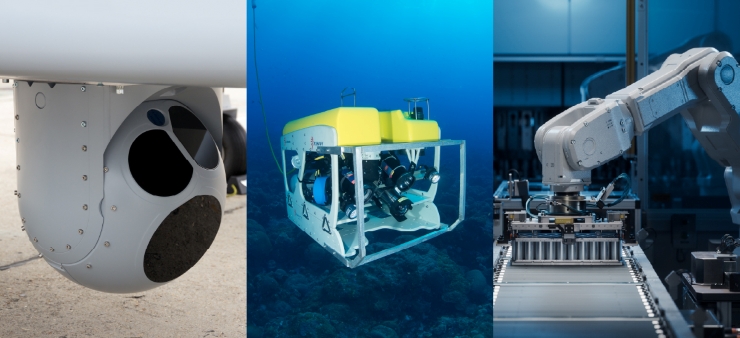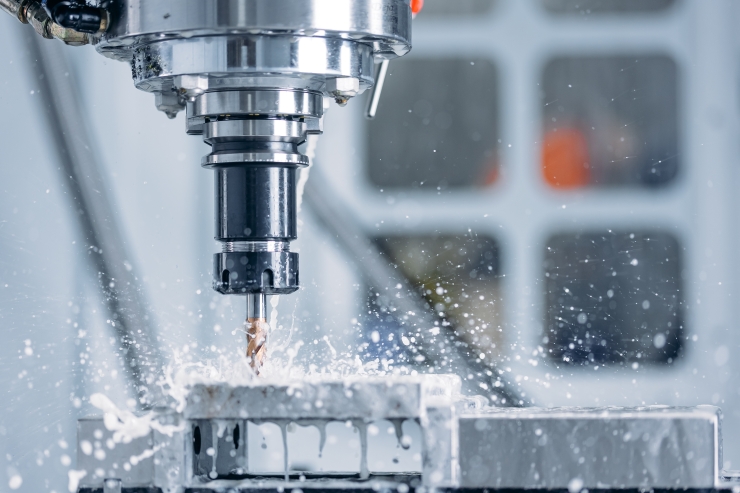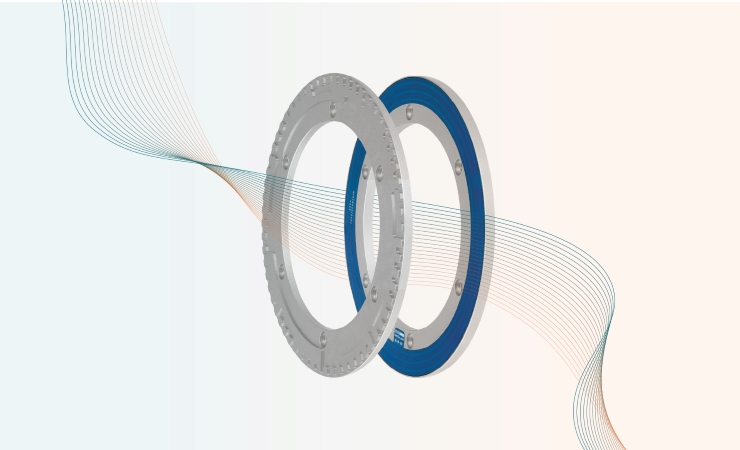Complete Guide to Inductive Encoders
A complete guide exploring what an inductive encoder is, how it works, characteristics and benefits, applications and more.
What Is an Inductive Encoder?
An inductive encoder uses electromagnetic induction to detect position, speed, and direction. It senses changes in the electromagnetic field caused by a patterned rotor made of materials that influence induction. These materials may enhance the field through magnetic permeability, reduce it through the creation of eddy currents, or affect it in both ways. As the rotor moves, the resulting changes in induction are captured by the stator’s sensor and converted into precise position data through signal processing.
Learn more about FLUX inductive encoders.
How Do Inductive Encoders Work?
Inductive encoders operate based on the principle of electromagnetic induction. They utilize a system of transmitter and receiver coils to sense the position of a moving conductive target. In contrast to optical encoders that use light, inductive encoders detect changes in inductance caused by movement. This makes them ideal for use in demanding environments and applications that require high accuracy.
Characteristics and Benefits of Inductive Encoders
Inductive encoders are a reliable solution for modern motion control applications, offering a range of key features and performance benefits.
- Exceptional Durability: Designed to resist dust, moisture, and chemicals, making them ideal for demanding industrial conditions.
- High Precision and Resolution: Inductive encoders offer outstanding positional accuracy, often reaching sub-micron levels. This makes them ideal for tasks that demand fine control, such as robotic systems, CNC machinery, and semiconductor processes. Sophisticated signal processing minimizes errors and delivers repeatable, high-quality results.
- Extended Lifespan: Built with no contacting parts, they experience less wear and tear, ensuring a longer operational life.
- Environmental Resilience: Less susceptible to temperature fluctuations or lighting changes compared to other sensor types.
- Space-Saving and Lightweight: The compact and lightweight build of inductive encoders makes them optimal for applications where size and weight are critical factors. This is especially valuable in applications where space limitations require efficient, precise components.
- Long-Term Cost Effectiveness: While the initial cost of inductive encoders may be higher than other options, their durability, reduced maintenance, and long service life can often result in lower total costs. This makes them a smart investment for applications requiring consistent performance and reliability over time.
Discover the benefits of FLUX’s innovative IND technology for inductive encoders.
Inductive Encoder Applications

Inductive encoders are used across a wide range of industries due to their reliability, versatility and performance, including:
UAVs, Aerospace & Defense
- Landing Gear Position Monitoring: Ensures correct deployment and retraction of the aircraft’s landing gear.
- Tracking Flight Control Surfaces: Monitors movements of rudders, flaps, and stabilizers.
- Targeting Alignment for Missile and Weaponry Systems: Real-time feedback for precision targeting.
- Autonomous UAV Navigation and Landing: Detects positional changes for smooth takeoff and landing.
Manufacturing and Heavy Equipment
- Precision Feedback for Robotic Arms: Provides accurate motion control for automation.
- CNC Machine Tool Position Sensing: Maintains machining accuracy and repeatability.
- Automated Conveyor Positioning: Tracks material handling system alignment.
Marine and Underwater Robotics
- Positioning of ROVs and AUVs: Supports underwater robotic navigation.
- Feedback for Diver Propulsion Systems: Enhances control in underwater movement.
- Subsea Valve Monitoring: Ensures safety in critical offshore infrastructure.
- Sonar and Imaging Device Alignment: Maintains accurate positioning for underwater cameras.
Medical Robotics and Healthcare Devices
- Real-Time Positioning for Surgical Robots: Enables precise control in robot-assisted surgeries.
- Sensors Compatible with MRI Environments: Tracks movement without magnetic interference.
- Motion Sensing for Prosthetics and Exoskeletons: Improves user mobility and responsiveness.
- Accurate Positioning in Automated Medical Equipment: Supports drug delivery and diagnostic devices.
Types of Inductive Encoders
There are several types of inductive encoders, each designed to meet specific motion control requirements:
- Absolute Inductive Encoders: These encoders provide an instant and accurate position value at power-up, which eliminates the need for homing procedures. This makes them an optimal choice for systems that require precise, fail-safe positioning right from the start.
- Incremental Inductive Encoders: Output pulses based on shaft movement and are typically used for speed monitoring and direction sensing.
- Single-Turn Encoders: Detect angular position within one rotation, which makes them suitable for limited-range applications.
- Multi-Turn Encoders: Track shaft position over multiple revolutions, allowing them to be used for machinery that operates across larger angular ranges.
Optical Encoders vs Inductive Encoders

Both optical and inductive encoders serve to track position, speed, and direction in motion systems, but their technologies and use cases differ significantly. Optical encoders rely on a light source and photodetector to read patterns on a rotating disc, offering high resolution ideal for clean, controlled environments. However, they are sensitive to dust, oil, and temperature extremes, and can fail under vibration or shock.
Limitations of Optical Encoders:
- Vulnerability to Contaminants: Optical sensing elements can be disrupted by dust, oil, moisture, or dirt, which may lead to degraded performance or signal loss.
- Sensitive Components: Optical encoders feature intricate components that are vulnerable to damage from high shock, vibration, or physical impact.
- Environmental Sensitivity: Optical encoders may struggle in extreme temperature conditions, which can affect their reliability and accuracy
In contrast, an inductive encoder uses electromagnetic induction to detect movement, without the need for optical components. This makes them highly durable and resistant to contaminants, mechanical stress, and electromagnetic interference. As a result, inductive encoders excel in harsh industrial, outdoor, or EMI-prone settings, such as manufacturing plants, medical devices, or heavy-duty equipment.
Read the article comparing optical encoders vs. inductive encoders and discover why inductive encoders are the better choice in harsh environments.
Capacitive Encoders vs Inductive Encoders

Capacitive and inductive encoders are both non-contact technologies, but they differ significantly in their operating principles and environmental performance. Capacitive encoders detect position through changes in capacitance caused by variations in a rotor’s electrical permittivity. Known for high resolution and compact design, they’re a good fit for clean, space-limited applications like precision robotics or semiconductors.
Limitations of Capacitive Encoders:
- Vulnerability to Contaminants: Capacitive encoders depend on electric field interactions, which can be disrupted by dust, moisture, or oil, leading to reduced accuracy or failure.
- Environmental Sensitivity: These encoders may struggle in harsh conditions, where external factors affect their performance and reliability.
In contrast, inductive encoders use electromagnetic induction to detect position and motion. They tolerate wide temperature shifts, resist EMI and mechanical shocks, and are less affected by environmental contaminants. Their mechanical robustness and thermal compatibility, especially when integrated into systems with matching materials, make them ideal for demanding industrial, aerospace, and defense environments.
Read the article comparing capacitive encoders vs. inductive encoders and discover why inductive encoders are the superior option in harsh environments.
Accuracy and Resolution in Inductive Encoders
An inductive encoder offer a balance of accuracy and resolution, making them ideal for demanding environments:
- Accuracy: Valuable for applications such as robotics, medical devices, and motion control, where precise positioning is needed. Inductive encoders ensure reliable, sub-degree accuracy, even in challenging conditions.
- Resolution: High-resolution outputs are a key feature of advanced inductive encoders, allowing for smooth motion control and fine adjustments. However, a high-resolution encoder without sufficient accuracy may introduce errors due to mechanical tolerances or signal distortion.
- Stability: Inductive encoders maintain consistent performance across a range of environmental challenges, such as temperature fluctuations, vibration, and electrical noise.
- Integration: Their compact size and frameless design make them ideal for integration into embedded systems, where space is limited but performance requirements remain high.
How to Select the Best Inductive Encoder for Your Design Requirements
Selecting the right inductive encoder for your design requirements depends on several factors. To ensure optimal performance and long-term reliability, the following should be considered:
- Application Requirements: Determine the required resolution, accuracy, and response time for your inductive encoder application.
- Environmental Conditions: Evaluate the operating conditions such as temperature, dust, moisture, and vibration levels.
- Mounting Constraints: Select a suitable encoder form factor that’s based on your mechanical design.
- Signal Output & Interface: Verify the encoder is compatible with your system interface, such as SSI, BiSS, or analog output.
- Maintenance Expectations: Choose a contactless inductive encoder design to minimize wear and reduce the need for maintenance.
Ensuring Reliable Performance of Inductive Encoders

Inductive encoders often operate in harsh industrial environments where reliability is imperative. To ensure consistent performance, consider the following environmental factors:
- IP Rating: Choose encoders with a high IP rating, offering protection against dust, oil, and moisture.
- Operating Temperature Range: Select inductive encoders that can operate accurately in both high and low temperatures.
- Resistance to Vibration and Shock: Ensure mechanical stability and longevity by selecting encoders designed to withstand shock and vibration.
- Electromagnetic Compatibility: Select inductive encoders that are resistant to electromagnetic interference (EMI) to maintain signal accuracy in electrically noisy environments.
Custom Inductive Encoders
Custom inductive encoders are designed to meet the exact mechanical and electrical requirements of your application. Unlike off-the-shelf models, these encoders are designed to fit unique form factors, output interfaces, and environmental conditions, making them ideal for challenging use cases.
Built for durability, inductive encoders are inherently resistant to dust, oil, vibration, and EMI. With no contacting parts, they offer long-term reliability in harsh environments such as aerospace, robotics, heavy machinery, and oil & gas. Their rugged construction and sealed housings (IP67/IP69K) make them true industrial-grade sensors.
While standard encoders may offer quicker turnaround, custom solutions provide greater design flexibility. Engineers can specify everything from shaft size and mounting configuration to preferred communication outputs. This level of customization ensures optimal integration and performance in space-constrained or high-demand systems. From robotic joints to subsea equipment, custom inductive encoders deliver accurate, maintenance-free motion feedback, making them a smart choice for modern automation and control systems.
Leading Inductive Encoder Manufacturer
FLUX GmbH is a leading manufacturer of inductive encoders, specializing in advanced inductive technology that delivers high performance in the smallest package. Our inductive encoders are designed with exceptional immunity to magnetic and electromagnetic interference, allowing direct integration into all motor types. The lightweight, modular design enables extensive customization and flexible scalability.
Our inductive encoders deliver precise, contactless position feedback while being robust in challenging environmental conditions. FLUX focuses on providing reliable encoder solutions suitable for demanding industrial applications, supporting diverse customer needs with innovative technology.
Discover FLUX’s IND-MAX inductive angle encoder, delivering exceptional performance, durability, and a range of additional benefits even in harsh environments.
